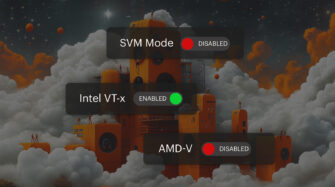Network assessment tools provide diagnostics and insights that are essential for optimizing IT infrastructure. With these tools, you can uncover vulnerabilities, see device configurations, and evaluate the health of a network infrastructure.
Let’s dive into why network assessments are important for onboarding clients and keeping their networks in peak condition.
The role of network assessments in onboarding
When you bring in new clients, a thorough network assessment helps you establish a solid foundation for network reliability, enhanced security, and operational efficiency.
Here’s how an onboarding process might look when paired with the right network assessment tools:
Install a remote agent
Start by confirming that your client is already set up in your system and their devices meet the required specifications. Once that’s done, install the network monitoring agent by selecting the client in your platform and applying the appropriate policy.
Assessment
Use a network assessment tool to map out your client’s network topology and evaluate its performance. Perform an inventory, documenting components like routers, switches, and access points. Collect configuration data, access control settings, and review all network policies. Use monitoring tools to gather performance metrics, such as traffic patterns and bandwidth utilization.
With this data in hand, you have a clear understanding of your client’s IT environment from Day One.
Implementation planning
Map out the technical requirements and system configurations needed to effectively manage your client’s IT environment. Focus on integrating monitoring tools, automating updates, and configuring security measures to build a reliable infrastructure.
You may also need to take corrective actions to improve security, optimize network performance, and ensure systems are current. Key areas to address include:
- Security enhancements: Update or install new firewalls and intrusion detection systems if necessary. Strengthen authentication protocols by implementing multi-factor authentication.
- Network optimization: Eliminate bottlenecks and improve performance by reconfiguring network components. This could involve subnetting, adjusting routing protocols, increasing bandwidth, or enabling Quality of Service (QoS) settings to prioritize critical applications and services.
- Infrastructure upgrades: Recommend replacement of outdated hardware to support higher data throughput and increase network capacity. Also, update software to maintain compatibility with current operating systems and applications.
- Policy and procedure updates: Review client IT policies to ensure they align with industry standards and regulations.
When should you assess client networks?
Aside from assessing a network during onboarding, you should perform a network assessment any time there are significant changes, like infrastructure upgrades, compliance updates, or organizational restructuring. A post-change network audit ensures your client’s network environment aligns with new requirements and remains secure, reliable, and optimized.
Key features of practical network assessment tools
Here are the core features that help you stay ahead of network issues:
1. Real-time monitoring
Imagine having a setup where you can see exactly what’s happening across a network at any given moment. If a client experiences a spike in network traffic or unusual logins, real-time monitoring shows you what’s going on as it happens.
2. Automated alerts
Automated alerts eliminate the need for manual monitoring metrics like CPU usage, memory load, and network traffic.
You can also customize RMM alerts to ensure you only get notifications for what matters most to you. For instance, you can define a threshold for failed user login attempts that triggers an alert for a technician (instead of getting an alert for every password typo).
3. Automated monitoring
Automated network monitoring provides a consistent flow of information that helps you understand trends, spot recurring issues, and make data-driven decisions.
Automated monitoring also enhances transparency and accountability within your team. Everyone gets access to network performance data, audit logs, and incident records, fostering a shared understanding of network conditions and priorities. This shared visibility can lead to more informed discussions and collaborative problem-solving efforts.
4. Integration capabilities
The best network assessment tools integrate with other essential software, ensuring consistent data flow and improving operational efficiency. A platform that supports integrations helps you manage all work from a central dashboard.
5. Routine task automation
Automated processes handle repetitive tasks like patch management and system updates, minimizing the risk of human error and ensuring tasks are completed consistently and accurately every time. The result is a more reliable and responsive network environment with reduced downtime, improved service delivery, and accelerated project timelines.
6. Scalability
The network assessment tools you choose should scale with your business as it grows, accommodating an increasing number of endpoints without compromising performance. This flexibility ensures you can continue meeting client needs effectively, regardless of how your operating environment evolves.
Syncro’s tools and features to support network management
Syncro tools simplify and enhance remote monitoring and management. Here’s how these features can help you maintain a more efficient and secure network:
Stay in control with device management
- Monitor system performance in real-time to detect issues like CPU spikes or low disk space before they escalate.
- Configure automated alerts to flag potential problems early, helping you reduce client downtime and keep operations running smoothly.
- Generate regular health reports to gain insights into device performance and plan for future needs.
Solve issues quickly with remote access
- Securely access and fix machines from anywhere, with single-click remote access.
- Address problems as they occur, avoiding delays and improving uptime for clients.
- Analyze remote usage patterns to easily identify and resolve recurring issues.
Organize tasks with intelligent ticket management
- Track and log issues with an AI-powered ticketing system that simplifies your workflows.
- Automatically attach client comments to every ticket.
- Shorten MTTR with AI-suggested remediations that help technicians work faster.
Choose the right tools to manage client networks
With the right technology and automation capabilities, you can effectively manage client networks 24/7. Syncro includes the features you need to improve service delivery, scale effortlessly, and track every task from start to finish.
Discover a better way to manage client networks. Sign up for your free trial today, and explore the depth of Syncro’s capabilities.
Share














